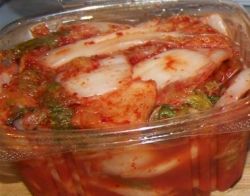Kimchi - An Intro

Tasty Spicy
This culinary accompaniement is to Korea what, in some respects, dill pickles are to the West -- only more so. Except with kimchi chopsticks are used instead of fingers!
In both cases "pickling" (fermentation) is the key to transmogrifying a vegetable which would otherwise spoil from being under attack by bacteria into an enduring triumph of taste. Kimchi ("kimchee") has the distinction, however, of adding red pepper to the process. Red pepper and a number of other delightful ingredients.
In the case of kimchi, the vegetable transmogrified is the one we call Napa cabbage or Chinese cabbage -- usually. (See below).
And we're not just in Korea anymore, Toto.
Kimchi has a wide following in the rest of the world. It's on your supermarket's shelves, in the refrigerated cases in the area where all the fresh vegetables are. Occasionally, though, a Korean stranded for a while in America will run out of kimchi. It's not likely, but it can happen. What does this person do for a substitute side dish to accompany, say, beef grilled Korean-style? -- A dill pickle!

How's it made?
Traditionally by throwing everything together in a big earthen jar and burying it in your backyard for the winter (the lid, however, stays above ground, giving access to the contents, which are frequently called upon of course). Most families prepared and buried more than one jar -- indeed many, many -- so that kimchi would be available the whole long winter. Modern dwellers of an 1lth floor condominium, however, do not have that option. So what do they do?
Some of them buy a special refrigerator which maintains an even temperature by cooling the interior walls rather than by cooling the air circulated within. This of course substitutes for the Korean winter and instead of popping off the top of a buried jar, you just open the refrigerator door. Isn't technology wonderful? (No doubt there are purists who will disagree and who will maintain that only kimchi prepared in the old-fashioned has the authentic taste).
Now, back to how kimchi is made. It is made with various cabbages or other vegetables of choice, combined with salt, sweet rice flour, red pepper flakes, fish sauce, minced onion, garlic and ginger, scallions, and East Asian chives. That at any rate is a general idea.

What kinds are there?
In fact, there are as many types of kimchi as there are vegetables, though of course many or the more exotic ones are infrequently used. Aside from the cabbages, like Nappa, some of the main vegetables used are these:
- radish (large oriental ones, sometimes whole, often cubed -- and delightully crunchy),
- green onion (particularly the green part), and
- cucumber. (Your mission, should you choose to accept it, is to develop the world's first artichoke kimchi. Who knows? You could become famous).
In fact, there are also innumerable variations on the ingredients which can be added when kimchi is made, including such non-vegetables as raw oysters and squid. Oyster kimchi, now there's a thought for us oyster lovers.


How's it taste?
Sour, spicy, bubbly, crunchy.
Delicious. There's the odor of fermentation, and the feeling of it, too, but it is all covered over by the power of the red pepper.
Delicious. A delicious contrast to whatever it is siding for: bulgoki, kalbi, bibimbap, even grilled chicken or fish. (Bulgoki is beef, kalbi is pork, and bibimbap is mixed).
It can be added to soups or stews for flavor; also to fried rice. Put some in with noodle dishese.
The radish kimchi tastes a little different from (and is more crunchy than) the cabbage kimchi, the scallion kimchi is a little different. . You get the idea.
Can I make my own?
You can. But that's a whole other story. There are lots of recipes on the net, including those for "quick kimchi." These are worth trying, particularly in a kimchee emergency, but they of course are not going to rival the real thing.
There are also youTube videos to walk you through the process. These in fact can be very entertaining; I recommend searching them out. Buying kimchee in an Asian store is of course a lot easier, but perhaps you are in it for the fun as well as the taste. More power to you.
One of the comments below inquires as to whether freezing newly made kimchi is a way to preserve it. To repeat what I replied there at the time: "fermentation is a preservation process of sorts, so I doubt that freezing would provide an additional advantage. You can keep kimchi in your fridge for a very long time without it being any less delicious."
True enough, and I would imagine that the jar being buried in the ground, together with heat generated by fermentation, prevents traditionally-made kimchi from freezing even during a cold Korean winter. I'd like to try it sometime to see, however, and hope to book a ticket to Korea sometime soon.
Parting facts
Kimchi can also be spelled "kimchee" or "gimchi, though there have been innumerable other variations over the years. (Try "chimchae" for example).
There is a Kimchi Field Museum in the capital of South Korea, Seoul. The museum states that there have been 187 varieties of kimchi over time. That's almost right up there with the number of shapes of pasta! Seasonings as well as ingredients vary. Some of the most popular are ginger, garlic (of course), diced radish,brine, scallions, various other spices, fish sauce, shrimp sauce, and oyster sauce.
You have to go to an Asian supermarket or food store to find different types of kimchi. Kimchi has made enough of an inroad that it can be found these days in most of the big chain supermarkets, but these stores generally carry only the kind made with cabbage. It is definitely worth a trip to the Asian stores, many of them run by Koreans, to pick up other types.
Part of a series
Pictures, pictures, pictures
Series within series, actually. Food & Cooking, for example, then -- within that -- series on vegetables, fruits, seafood, meat, etc. Books, too. Ideas, too. Travel, too. Click on "featured lenses" at the top of the right-hand column, under my profile, for the complete list. Key virtues:. pictures, clear step-by-step text. Delicious -- whether foods or ideas! All of the hubs in this series are collected in Lee White's Department Store.








